Understanding Rock Kits for Collectors and Enthusiasts


Intro
Rock kits are a vital component for those passionate about geology. They are not just collections of stones, but rather curated sets that enhance our understanding of Earth’s materials. For both beginner and seasoned collectors, rock kits serve to illustrate geological concepts and foster appreciation for our planet's diversity.
In this guide, we will explore the important aspects of rock kits. From understanding their significance to learning about assembly strategies, this article aims to provide valuable insights into the world of rock collecting.
Featured Collectible of the Month
Overview
This month, we are featuring the stunning Blue Celestite as our collectible. Blue Celestite is renowned for its calming color and translucent crystals, often sought after by both collectors and metaphysical practitioners. It typically forms in sedimentary environments and reflects the intricate processes of nature.
Historical Significance
Celestite has been used by humans for centuries. Its name derives from the Latin word 'caelestis,' meaning celestial. In various cultures, it was believed to hold spiritual significance, serving as a symbol of tranquility and enlightenment. Collecting Celestite allows enthusiasts to connect with both geological history and cultural narratives.
Identification Techniques
Visual Characteristics
When identifying rocks, several key visual characteristics should be considered:
- Color: Observe the overall hue and any variations in shades.
- Texture: Examine the surface. Is it smooth, rough, or granular?
- Form: Look at the shape. Does it have clear edges, or is it more rounded?
- Luster: Notice how light reflects off the surface. Some rocks may be shiny, while others are matte.
These traits offer important clues about the rock's composition and origin.
Resources for Identification
To assist in the identification of rock specimens, collectors can utilize a variety of resources, including:
- Online Databases: Websites like Wikipedia and Britannica provide extensive information about different rock types.
- Books: Field guides specifically focused on rocks and minerals can be invaluable.
- Communities: Engaging in platforms such as Reddit allows collectors to share insights and ask for assistance.
- Social Media: Groups on Facebook often discuss rock identification tips and showcase interesting finds.
"Successful identification requires attention to detail and a willingness to learn from others in the community."
The Concept of a Rock Kit
The notion of a rock kit extends far beyond mere assemblages of rocks and minerals. It's an organized collection designed to facilitate the exploration, study, and appreciation of geological wonders. For collectors and enthusiasts, understanding what constitutes a rock kit is vital. Not only does it enhance personal knowledge, but it can also foster community engagement and scientific curiosity.
A rock kit serves multiple purposes. It can be an educational tool for students and educators alike, providing hands-on experience with natural materials. For hobbyists, a rock kit is a way to indulge in exploration and study of local geology as well as samples from different regions. Knowing the concept of a rock kit can inspire and guide both new and experienced collectors in creating collections that reflect their interests and goals.
Defining a Rock Kit
A rock kit is fundamentally a curated selection of various geological specimens. These can include a wide variety of rocks, minerals, fossils, and sometimes tools for examination. The specific contents may vary significantly based on the collector’s preference and expertise. Essentials often include sedimentary, igneous, and metamorphic rocks, alongside minerals like quartz, calcite, and feldspar. These selections serve as foundations for understanding the natural world.
While each collector may have a unique perspective on what should be included, essential characteristics often remain consistent:
- Diversity of specimens, showcasing different rock types and formations.
- Quality of the sample, where greater emphasis is put on clarity and integrity.
- Educational value, ensuring specimens are not just aesthetically pleasing but also scientifically informative.
Each included piece adds context to the overall collection, making it not only an inventory but a comprehensive educational experience.
The Importance of Rock Kits in Collecting
Rock kits hold significant importance for collectors. They bridge the gap between casual interest and serious study, giving structure to the practice of collecting. With an organized approach, collectors can engage more deeply with their specimens.
Having a defined rock kit encourages collectors to:
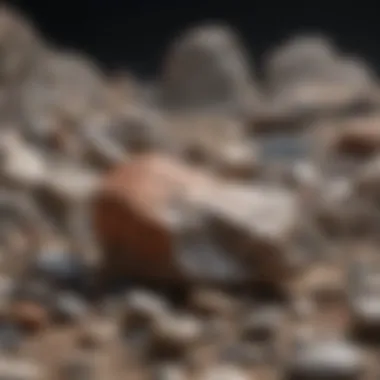
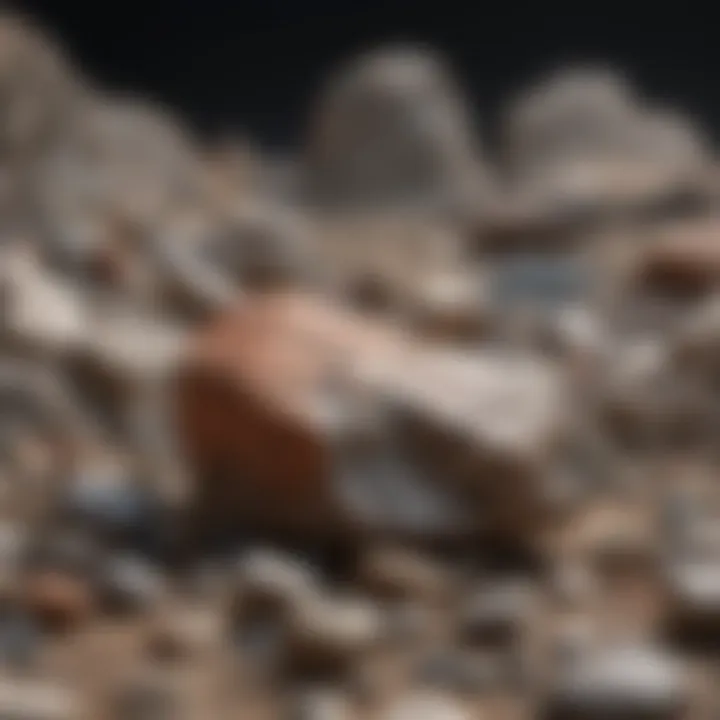
- Develop expertise: Systematically studying different types of rocks enhances geological literacy.
- Facilitate sharing: Educational rock kits can be used in community settings, promoting knowledge exchange among enthusiasts.
- Inspire future generations: By encouraging young people to explore rocks and minerals, we lay a foundation for future geologists and environmental stewards.
Furthermore, active participation in the collection enhances a sense of community among enthusiasts. Whether through local clubs or online forums, sharing experiences and knowledge adds a rich layer to the collecting process. Effective rock kits become springboards for discussions and collaborations, enhancing both personal enjoyment and collective wisdom.
Components of an Ideal Rock Kit
Having a well-structured rock kit is essential for enthusiasts and collectors. This section will delve into the critical components of an ideal rock kit by examining essential rocks and minerals, tools for identification, and educational resources that support the collector’s journey.
Essential Rocks and Minerals
To build a meaningful rock kit, collectors should include a variety of essential rocks and minerals. Some key examples are:
- Igneous Rocks: Basalt and Granite are fundamental as they showcase volcanic activity and formation processes.
- Sedimentary Rocks: Limestone and Sandstone represent how sediments consolidate, offering insight into geological history.
- Metamorphic Rocks: Slate and Marble illustrate the transformation of rocks under heat and pressure.
- Minerals: Quartz, Feldspar, and Calcite are crucial due to their frequent appearance in various rock types.
Incorporating a diverse range allows collectors to observe the distinct characteristics and properties of each sample. This variety promotes a comprehensive understanding of geological processes and the rock cycle.
Tools for Rock Identification
To effectively identify and study rocks and minerals, certain tools are indispensable. Here are some basic tools that every collector should consider:
- Hand Lens: A magnifying glass helps in observing fine details such as texture and color.
- Rock Hammer: Useful for breaking rocks and exposing fresh surfaces for analysis.
- Field Guide: A reliable book or digital resource provides essential information on identifying various rock types.
- Streak Plate: This assists in determining the color of a mineral's powder, a helpful identification aspect.
Using the right tools not only assists in identification but also enhances the overall experience of rock collecting. They allow deeper insight into the characteristics that define each rock type.
Educational Resources and Guides
Educational resources play a crucial role in supporting collectors at all levels. Here are some vital resources:
- Books: Titles like "Rocks and Minerals" by Chris Pelkie offer foundational knowledge while engaging readers.
- Online Courses: Platforms like Coursera and edX offer geology courses that are beneficial for both beginners and advanced learners.
- Websites: Engaging with websites like Wikipedia and Britannica provides extensive information on geological topics.
- Community Forums: Participating in forums on platforms such as Reddit can connect you with other enthusiasts, share experiences, and gather insights.
These resources not only help in understanding the materials included in a rock kit but also stimulate a continuous quest for knowledge about the broader field of geology. The integration of such resources enriches the experience and makes the journey of rock collecting more fulfilling.
Educational Value of Rock Kits
Rock kits serve as a valuable resource not only for enthusiasts but also for educational institutions. They offer a hands-on approach to learning about geology, fostering curiosity and knowledge. The educational value of rock kits lies in their ability to bridge theory and practice. Students and collectors alike benefit from direct engagement with geological specimens, which cultivates an interactive learning environment.
The involvement of rock kits in education is diverse, spanning different learning stages—from K-12 education to higher education and research. This diversity allows educators to tailor rock kits to meet specific educational goals, ensuring relevance and efficacy in teaching.
Role in K-12 Education
In K-12 settings, rock kits play a pivotal role in introducing geology concepts. They provide tangible examples of minerals, rocks, and fossils, helping students grasp fundamental principles of earth science. Integrating rock kits into the curriculum enhances critical thinking abilities. Students can examine samples, make observations, and develop hypotheses based on their findings.
Using rock kits in classrooms promotes active engagement. It encourages collaborative learning experiences where students work together on classifications and identifications. This not only enhances teamwork skills but also encourages discussion and knowledge sharing.
Moreover, rock kits serve as an excellent tool for fostering a lifelong interest in geology. By exposing young minds to the wonders of the earth, these kits inspire students to further explore the sciences and pursue relevant educational paths. This early exposure is crucial as it lays a foundation for future academic pursuits.
Advancing Higher Education and Research
For higher education and research, rock kits are equally significant. At the university level, geology students can use these kits as part of their practical training. Advanced study involves analyzing samples, conducting experiments, and engaging in fieldwork. Rock kits complement this work by providing necessary materials. They allow students to familiarize themselves with different mineral types and their properties.
Research activities can also benefit from these kits. Researchers can create custom kits tailored to specific geological studies. This flexibility enables them to focus on particular variables in their research, leading to deeper insights. Distribution of rock kits in research promotions assists in disseminating knowledge and fostering collaboration.
Overall, the educational value of rock kits is undeniable. They not only spark interest among students but also build practical skills applicable in the broader field of geology. Their role in education—both at K-12 and higher levels—continues to evolve, marking them as essential tools for anyone invested in understanding our planet.
Collecting Strategies for Rock Kits
Collecting rocks and minerals requires thoughtful strategies to build a meaningful kit. Proper collecting strategies can enhance the experience, knowledge, and skills of collectors, making the entire process rewarding. Each aspect, from sourcing valid specimens to organizing them effectively, plays a critical role in developing a collection that is not just diverse but also educational.
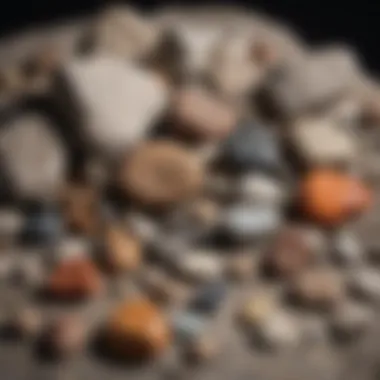
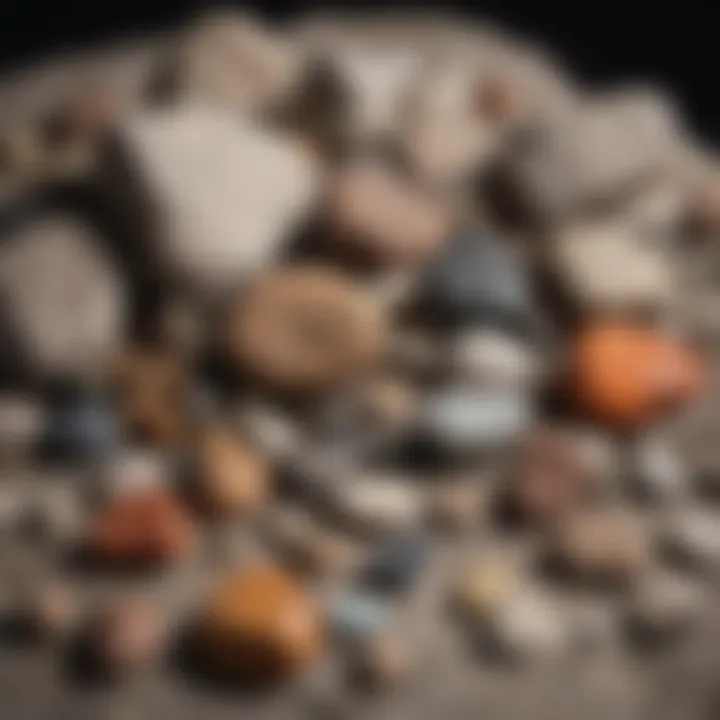
Sourcing Rocks and Minerals
Sourcing rocks and minerals involves identifying reliable locations where collectors can find specimens. Natural landscapes, such as mountains, riverbeds, and quarries, often yield interesting materials. Before visiting a site, research geological features in the area. Local geology maps and topographic studies can guide potential collectors to promising locations. Environmental regulations and rules should guide the collecting process. Responsible collecting protects the environment and preserves natural history.
There are also numerous shows and events across the country where collectors can acquire fine samples. These events often host vendors specializing in rocks, minerals, and fossils. Participating in these gatherings presents an opportunity to network with other collectors, gain insights, and learn about new trends in the field. Collectors may also consider online platforms like eBay or Etsy for purchasing unique samples. However, assessing the credibility of sellers is crucial for ensuring quality.
"Sourcing the right rocks is only a part of the journey; understanding their story adds real value to the collection."
Establishing a Categorization System
An effective categorization system is vital for managing a rock collection. Organizing specimens by type, origin, or condition can streamline identification and provide context for each piece. For example, categorizing by type can include igneous, sedimentary, and metamorphic rocks, while categorizing by origin might consider local, national, or international sources.
Additionally, labeling each specimen with relevant information can enhance the educational value of a rock kit. Information might encompass the name of the rock, its specific characteristics, and the location it was found. Collectors can opt for simple label systems or more detailed digital inventories. Using apps or software dedicated to specimen tracking can offer a more modern approach to organization.
Potential strategies for categorization include:
- Physical storage: Use labeled boxes or bins to store different types of rocks together.
- Digital cataloging: Utilize a spreadsheet to compile details about each specimen.
- Display methods: Consider exhibiting pieces in a way that facilitates easy viewing and learning.
Maintaining and Preserving Rock Kits
Maintaining and preserving rock kits is crucial for any collector or enthusiast. Proper care ensures the longevity and aesthetic appeal of each specimen. Collectors invest time, money, and passion into assembling their rock collections. Thus, neglecting their upkeep can result in deterioration and loss of value. Understanding how to maintain these rocks properly enhances the overall experience of collection.
Cleaning and Care Techniques
Cleaning rocks and minerals in your collection may seem straightforward. However, it requires careful consideration to avoid damage. When dealing with various materials, you might find each requires a unique approach. It's essential to remove dirt and debris without using harsh chemicals.
- Gentle washing: For most specimens, rinsing with clean water and soft brushes is effective. Avoid hard scrubbing, as this can scratch delicate surfaces.
- Avoid soaps and chemicals: Common soaps can leave residues that accumulate and affect appearance. If something stubborn exists, use a diluted solution of baking soda.
- Air drying: Let the specimen air dry naturally after washing. Avoid direct sunlight, as it can fade colors or damage some minerals.
Furthermore, you may want to consider the specific care needed for fragile specimens. Some minerals might require additional protective measures, like keeping them in controlled humidity conditions.
Storage Solutions for Longevity
Proper storage of rock kits not only preserves physical condition but also enables easier access for study and display. Ensuring that your rock samples are stored correctly can mitigate the chances of damage caused by environmental factors.
There are several effective storage solutions:
- Use acid-free boxes: Store specimens in acid-free boxes to prevent chemical reactions. This also helps block light exposure.
- Display cases: If you prefer showcasing your collection, consider using a glass display case. This protects from dust and physical impact while allowing visibility.
- Labeling: Clearly label each specimen for easier identification. Ensure that labels are made with non-acidic materials to prevent staining.
- Temperature and humidity control: Avoid extreme temperatures and fluctuations in humidity. Maintain a stable environment to protect minerals from degradation.
Proper maintenace of rock kits enhances not only the display but also the educational value of your collection.
By incorporating these cleaning and storage practices, collectors can ensure that their rock kits remain vibrant and intact for years to come. Each specimen will not only retain its value but also contribute to the ongoing joy of rock collecting.
Customization of Rock Kits
Customization of rock kits allows enthusiasts and collectors to create a personalized experience that reflects their unique interests and preferences. Customizing a rock kit is not just about assembling various rocks and minerals but also about enhancing one's engagement with geology. The benefits of customization include a deeper understanding of personal interests, a tailored collection that represents local geology and personal experiences, and a more meaningful educational journey.
Tailoring Kits to Personal Interests
When collectors tailor their rock kits, they observe how their interests can significantly shape their collecting experience. Interest can vary widely, from general geological features to particular rock types, like igneous or sedimentary rocks. Collectors should reflect on what intrigues them.
- Identifying Interests: Understanding the specific types of rocks and minerals that resonate can spark excitement. If a collector enjoys fossils or gemstones, these can be the focal point of their kit.
- Custom Themes: Developing a theme for the kit can create a cohesive collection. For example, a collector might focus on metamorphic rocks or a specific geographic region.
- Skill Level Consideration: Beginners may want to start with basic samples while experienced collectors may seek rare or more challenging specimens. Each collector can adjust the kit components based on their skill level.
Such tailored kits make the collection feel more personal. Collectors feel a stronger connection to their pieces when they understand the stories and significance behind each sample.
Incorporating Local Geological Samples
Incorporating local geological samples into a rock kit establishes a direct connection to the environment. Local geology reflects the natural history and processes of the area. This practice brings several advantages.
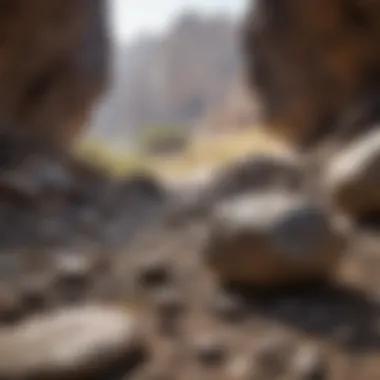
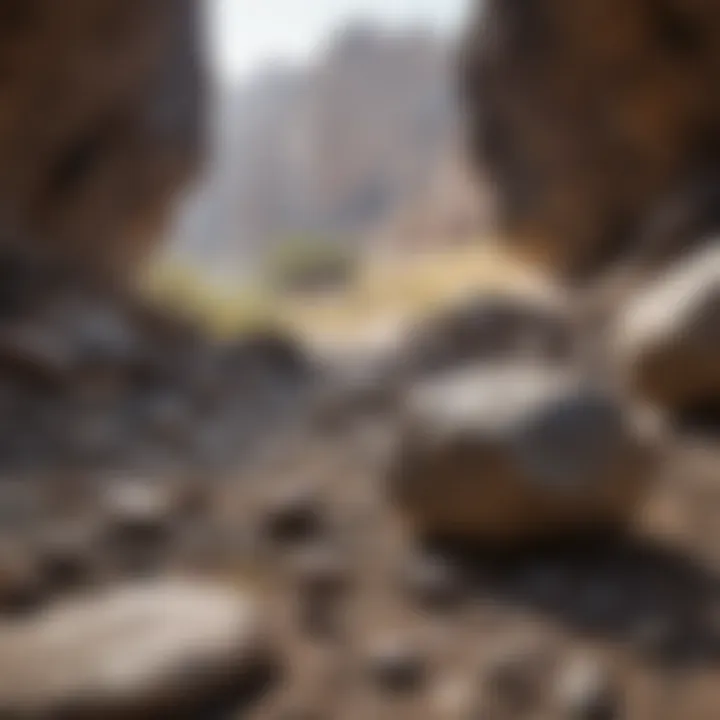
- Educational Insight: By learning about the geological formations nearby, collectors gain insight into the regional landscape's history and formation processes.
- Personal Experience: Local samples can hold personal significance, as collectors often have memories tied to specific locations—quarries, mountains, or riverbeds where they found their specimens.
- Community Engagement: Using local specimens can foster community ties. Engaging in local geology exploration may lead to connections with fellow enthusiasts and experts.
Assembling a rock kit that features local geological samples enriches the collecting experience. It encourages exploration and appreciation of the earth's diverse geological treasure.
The joy of rock collecting often stems from a personal connection to the items in one's collection. Customization amplifies this joy by ensuring that every rock has meaning.
Community and Sharing Knowledge
The importance of community and knowledge sharing in the realm of rock kits cannot be overstated. For collectors and enthusiasts, these elements provide a rich soil for growth, fostering connections that enhance both understanding and appreciation of geology. Engaging with a community presents opportunities for learning from one another, sharing discoveries, and cultivating collective wisdom. Here, we will explore two key avenues for connecting within the rock-collecting community: joining collectors' associations and participating in online forums and groups.
Joining Collectors’ Associations
Joining a collectors' association offers many benefits for anyone passionate about rocks and minerals. These organizations often act as a bridge, connecting members who share similar interests. By being part of such an association, one gains access to valuable resources, including newsletters, educational materials, and even field trips.
Many collector associations also organize events or exhibitions that allow members to showcase their collections. This not only provides an avenue for feedback but also cultivates a sense of belonging and pride.
Additionally, being part of an association may lead to mentorship opportunities where seasoned collectors share their knowledge with newcomers. This is particularly beneficial for those still navigating the vast world of geology. Members can ask questions or seek guidance on identifying minerals, acquiring tools, and expanding their collections more effectively. The camaraderie developed within these groups enhances the overall experience of collecting, making it both educational and enriching.
Engaging in Online Forums and Groups
Online platforms have emerged as crucial spaces for sharing knowledge and experiences among rock collectors. Engaging in forums and groups dedicated to geology fosters a sense of community that transcends geographical boundaries. In these digital environments, members can freely discuss their interests, share photos of their collections, and provide insights into their collecting strategies.
These platforms also serve as a repository of knowledge, where a wealth of expertise is just a post away. Questions can be answered, and knowledge can be exchanged in real time. For instance, Reddit features various threads that cater to geology enthusiasts, facilitating discussions on everything from rock identification to the latest in scientific research. Similarly, Facebook groups exist where one can share experiences and resources with others in the field.
Moreover, these online interactions can lead to valuable partnerships. Collectors often find others willing to trade specimens, offer tips for local sourcing, or even collaborate on education initiatives. This collaborative spirit not only enriches individual collections but also contributes to a shared understanding of geological diversity.
Connecting with others enriches the collector's journey, deepening both understanding and appreciation for rocks and minerals.
Future of Rock Kits in Education and Collecting
The future of rock kits holds significant promise for both educational contexts and personal collecting practices. As the field of geology evolves, so too does the approach to how rocks and minerals are studied and appreciated. Rock kits will adapt to these changes, integrating new ideas and technologies that enhance the learning experience for collectors, students, and enthusiasts alike.
Innovative Trends in Rock Collecting
One notable trend in rock collecting is the growing focus on sustainability. Collectors are becoming more aware of the environmental impact of collecting practices. Sustainable sourcing of rocks and minerals means prioritizing ethical collection methods and being conscious of the ecological footprint. For instance, many collectors now favor purchasing from suppliers who adhere to responsible mining practices, which help preserve natural habitats.
Moreover, immersive experiences are on the rise. Activities such as geological field trips and hands-on workshops are becoming more popular. Such experiences not only enrich knowledge but also foster a deeper connection to the materials. Collectors are now looking for kits that include field notes or curated itineraries that guide them to local sites of interest. These innovative trends underline the evolving nature of rock collecting, highlighting a shift from mere ownership to an enriched learning journey.
Integrating Technology in Rock Kits
Technology plays a crucial role in the future of rock kits. Digital tools are enhancing the way collectors engage with their collections. Mobile applications for rock identification and augmented reality tools are making it easier to learn about specific specimens. For example, collectors can scan a rock’s barcode to receive detailed information about its geological background, origin, and associated data. This integration of tech not only enhances the learning experience but also makes collection management more organized and efficient.
The incorporation of technology in rock kits can significantly elevate the educational experience, making it more interactive and informative.
Another aspect is the use of online platforms to share discoveries and knowledge. Collectors are utilizing social media, forums, and websites to connect with others in the community. This fosters collaboration and encourages individuals to share their collections, tips, and experiences. Digital networking enriches the educational aspect of rock collecting and allows for a community-driven approach to learning.
As the landscape of education and collecting shifts, innovations like these will play a pivotal role in shaping future rock kits. Collectors must stay abreast of these developments, ensuring their kits remain relevant and beneficial in an ever-evolving field.
Culmination
Rock kits serve as invaluable tools for both new and seasoned rock and fossil collectors. The significance of rock kits lies in their ability to evoke a deeper understanding of geological principles while fostering a genuine appreciation for natural history. They are not merely collections of stones; instead, they represent a curated journey through the earth's history. This journey enhances learning and encourages hands-on engagement with geology, which is crucial for collectors.
Recap of the Importance of Rock Kits
In summary, rock kits are fundamental for a diverse range of individuals. They provide educational value through organized collections that highlight various rocks and minerals. Understanding the essential components of a rock kit, such as the types of rocks included and the tools necessary for identification, is crucial for gaining a comprehensive overview of geology. Moreover, rock kits encourage the development of critical thinking skills as collectors engage with the nuances of classification and collection. The educational resources linked to these kits further enrich the learning process, making them an essential resource for schools and personal exploration alike.
Encouragement for Further Exploration
Venturing beyond the basics of rock collection can be profoundly rewarding. Collectors are encouraged to connect with communities—both local and online. Engaging in associations and discussions on platforms like Reddit or Facebook can provide insights into regional geological features, intriguing specimens, and advanced techniques for collecting and preserving rocks.
A willingness to explore new areas, expand collecting strategies, and employ innovative technologies can transform a simple rock collection into a dynamic repository of learning and discovery. The world of rock collecting is constantly evolving, and remaining curious can open numerous horizons for enthusiasts, fostering both personal growth and academic enrichment.
Remember, every stone you encounter has a story to tell. Embrace the journey.



